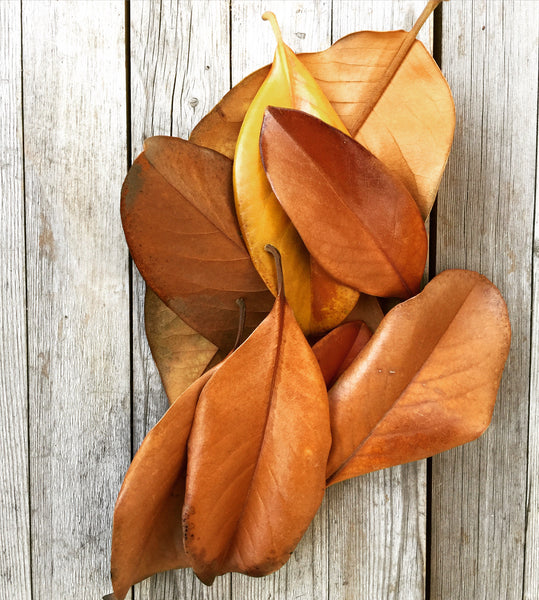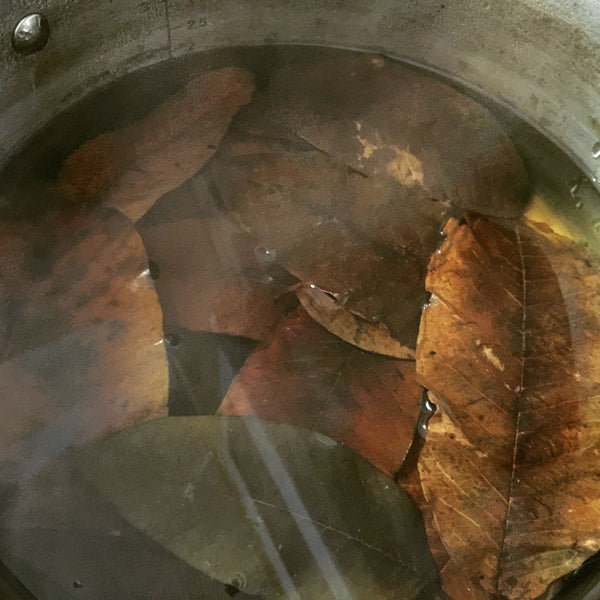- Continue Shopping
- Your Cart is Empty
Gathering leaves, fighting ignorance, and fostering a movement...
As a vendor proffering the use of natural materials in our aquariums, it's important now and then that we look at stuff you can do on your own.
Huh?
Well, yeah, even though I earn my living selling you botanical materials we source from around the world, I'd be totally remiss if I didn't occasionally bring up the fact that you can collect some of your own! (I Know, this isn't the first time we've talked about this...) In fact, I encourage you to do it once in a while!
Really.
This is more about me wanting to foster a botanical-style, blackwater/brackish aquarium movement- helping grow a concept- than it is about me trying to be the worldwide dominating purveyor of "leaves and twigs."

And inevitably, as happened recently, someone feels compelled to "point out" that you can grab your own sometimes, as if we weren't aware of that. It happened recently, in fact, which prompted me to brush off this topic and roll it out yet again. I had some schmuck make the obvious and asinine comment on a Facebook post that "...all of the stuff you sell can be collected in your backyard. Do you think people are stupid?"
Um, not really.
In fact, I felt that he was the only stupid one...I mean, the guy really thought that I was in this "ignorance bubble" where he felt that I was sitting in some office laughing at everyone who purchases botanicals from me, and that he was "exposing" me as if I were running some scam...Did this guy ever even bother to visit our site, read one of our blogs, follow our community?
Nah. Easier to just make some absurd comment than to do any homework.
Yes, I admit that the comment was so lame as to trigger those typical instinctive "%&^*% you ignorant moron!" responses, which I thankfully withheld. It's never good to explode in public, lol. (says the guy who/s writing about it now!)
I mean, maybe the guy's absurdity was applicable to some people. Maybe some guys who sell botanical materials think that you can sucker people into stuff, and that their leaves are somehow the only ones out there? I don't know, because I don't look at it that way. I'd like to think that most of us who sell botanical materials for aquarium use are (well, I am, anyways) keenly aware that you can collect some of this stuff yourself.. I encourage you to do so when you can.
I get it, I suppose... Some people like to think that they're playing the role of self-appointed "crusading consumer advocate" or something. And of course, the counter-argument goes like this: You can also grow your own vegetables, hunt your own meat, sew your own clothing, build your own laptop, drive yourself to the airport, breed your own cichlids, make your own fish food, etc...It's a function of convenience as much as it is about anything else. If you want to spend your weekends slogging through forests, jungles, whatever and collect some stuff yourself, go for it! It's actually fun!
However, if you're in a Nordic climate, big city, or other situation where you don't have easy access to stuff like Mangrove leaves, Kachnar Tree Pods, "Savu Pods", Catappa Bark, etc., we'd hope that you'd consider purchasing from us. I'd like to think that our support of the aquatic community, clubs, events, magazines, and the resources we've created on this page (some 600 or so blogs and growing now) would at least make you think of us before that guy on eBay!
So, yeah...enough about that. As you know, I like to share "stuff" with you- our community- so I hope you don't belittle me sharing my opinions, lol. And I worry that there are many of you who want to start different kinds of aquatic businesses and are intimidated by the occasional criticisms and attacks you might face from time to time. It's okay, you can handle it.
Back to the point...
TAKEAWAY: You can use leaves and botanicals which you can collect yourself.
We have a lot of people ask us if they can use "such and such" a leaf or seed pod, or whatever they collected nearby -in their aquarium. And quite frankly, for many items, my thinking is that you should give them a try...conditionally.
"Woah, he's advocating collecting your own stuff? Doesn't he have a business? What? Why would he do that?"
Well, those of you who follow us know that we've been encouraging this from day one. This idea of collecting your own leaves and such is nothing new...people have been collecting various leaves and other botanicals for years.
Just a few things to do before you hit the woods...your backyard, local park, or wherever...
First off, you should get an identification about the item(s) you're collecting. You can either look 'em up online ("Did you know that there's now this incredible web page on the 'information superhighway' called Google! It can get you answers for lots of stuff quickly! Try it next time you're on the world wide web!") or purchase a nice field guide to plants native to your region.
Sarcasm aside, there is no excuse for not doing your homework here.
The first, and perhaps most important of these aforementioned "conditions" is that the plant you're thinking of trying is not a known toxic plant to humans or animals. Yeah, I know we're talking about fishes, but this is really a consideration. If something is known to be generally poisonous, I'd steer clear. You'll need to do your homework online, or speak with a botanist or someone well-versed in the native flora of your region if you're not sure.
The other "condition" with a lot of self collected botanical items is that they are not sourced from areas with agricultural pesticides, serious pollution, etc. In other words, if their not subjected to contaminants where they sit. You know, laying on oily highways, or fallen into obviously polluted water, etc.
Many items are easy picking, and have proven to be safe and useful almost year-round.
For example, Alder Cones and Birch Cones, which are found in many parts of North America and Europe, are perfectly safe to use, as long as they are from the aforementioned clean areas, and are properly prepared for use.
And then, of course, the leaves...
Oak trees of various types yield nice leaves that, when dried, have been a mainstay of hobbyists in North America and Europe or years, as have been Beech and even Alder. They work great in aquariums, in my experience, although my biggest personal "complaint" about some of them is that they look...exactly like Oak leaves...not the sort of aesthetic you're looking for in a tropical South American, African, or Southeast Asian aquascape! However, some of the ones we call "Live Oak" are actually amazing...to the point where we began offering them recently (and our community loves 'em!)!

And, this brings us to our third "condition" which applies specifically to leaves. When you collect these leaves, it's important to collect naturally fallen leaves, ones which have depleted their stores of sugar and are already sort of brown and crispy. This being Autumn and all in the Northern Hempishere, the timing couldn't be better for this kind of fun!
Yeah, "dried and crispy" is the call here.
My one exception is for Magnolia leaves.
While you can use them nice and crispy, I personally prefer them when they're recently fallen and not quite dried up. In this particular state, they're not only more attractive, I think they tend to last a bit longer and prepare better...and they recruit biofilms nicely!
And, just like the botanical materials you'd purchase from us or other sources (Really? You'd still do that after all of the free information I offer daily? Arrghhh...😂), you need to employ common sense, an abundance of caution, and take the time to prepare them before utilizing in an aquarium. No different than what we preach daily, right? And of course, test and add things very slowly, knowing that there are always risks associated with adding any botanicals to your aquariums, regardless of source.
So yeah, it's quite possible to grab some of your own stuff and enjoy it in your aquariums. No mystery here. Just like breeding your own fish or collecting your own Daphnia...there are some guidelines, techniques, and processes to be aware of, but that's about it.
Nothing really new here, right? Put on the boots, grab the insect repellant, set out, and have fun!
Identify, verify, collect, prepare, test...enjoy.
Stay adventurous. Stay intrigued. Stay cautious. Stay patient...
And Stay Wet.
Scott Fellman
Tannin Aquatics











Scott Fellman
Author